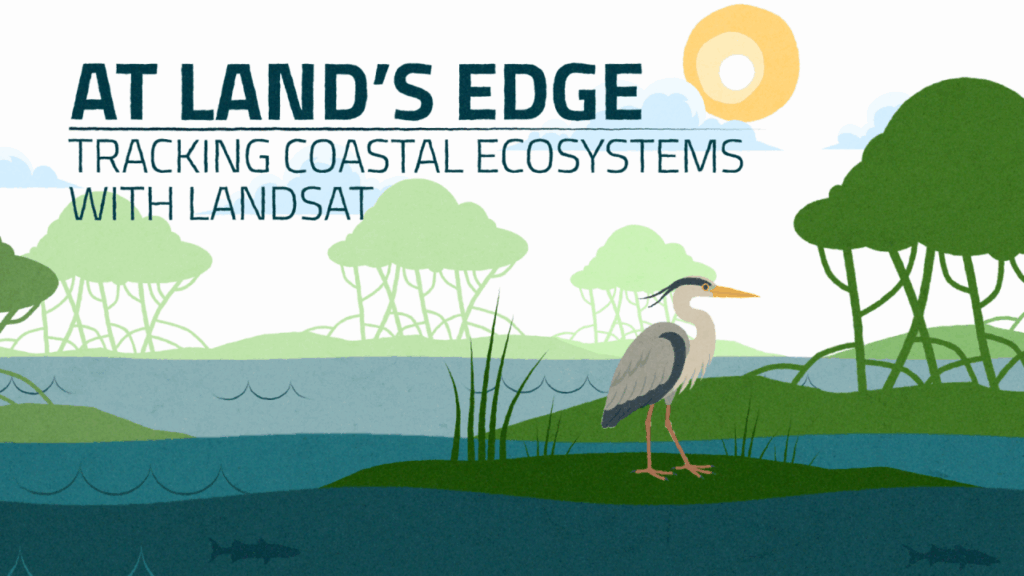December 03, 2020 • This new four-part video series shares the history of NASA/USGS Landsat, how Landsat 9 works, how Landsat data gets from the satellite to the ground, and how Landsat data can be used with other data to support a wide range of research and applications. Enjoy!
Part I
Landsat 9: Getting Off The Ground
Every legacy has a compelling origin. The soon-to-be-launched Landsat 9 is the intellectual and technical product of eight generations of Landsat missions, spanning nearly 50 years. Episode One answers the question “why?” Why did the specific years between 1962 and 1972 call for a such a mission? Why did leadership across agencies commit to its fruition? Why was the knowledge it could reveal important to the advancing study of earth science? In this episode, we’re introduced to William Pecora and Stewart Udall, two men who propelled the project into reality, as well as Virginia Norwood who breathed life into new technology. Like any worthwhile endeavor, Landsat encountered its fair share of resistance. Episode one explores how those challenges were overcome with the launch of Landsat 1, signifying a bold step into a new paradigm.
Part II
Landsat 9: Designing For The Future
The soon-to-be-launched Landsat 9 is the intellectual and technical product of eight generations of Landsat missions, spanning nearly 50 years. Episode 2 takes us inside the spacecraft, showing how Landsat instruments collect carefully calibrated data. Scientists have used the data to manage natural resources and answer questions about changes since the program started in 1972. In this episode, we’re introduced to Matt Bromley, who studies water usage in the western United States, as well as Phil Dabney and Melody Djam, who have worked on designing and building Landsat 9. Together, they are making sure that Landsat continues to deliver game-changing data and continues to help manage Earth’s precious resources.
Part III
Landsat 9: More Than Just A Pretty Picture
It’s not enough just to record data with a satellite; you also need to analyze it here on Earth. Episode 3 shows the efforts of the USGS to downlink and archive the five decades of Landsat data we’ve collected, as well as make it available for scientists and other data users. In this episode, we’re introduced to Mike O’Brien, who is on the receiving end of daily downloads, as well as Kristi Kline, who is in charge of making Landsat data available at no cost to the user. Jeff Masek, the Landsat 9 Project Scientist at NASA, describes how access to data has revolutionized what we can learn about our home planet. More than just pictures, Landsat’s verified scientific data is giving us a slice of human history and the changes on Earth’s surface.
Part IV
Landsat 9: Plays Well With Others
Landsat is not the only satellite orbiting Earth and sending back data. It takes a team of data sets to get the full picture of what’s happening down on the surface of Earth. Episode 4 shows how Landsat is combined with other data sets to reveal what is happening as well as why. In this episode, we’re introduced to Danielle Rappaport, who uses audio recordings with Landsat data to measure biodiversity in rainforests. Jeff Masek, the Landsat 9 Project Scientist at NASA, describes using Landsat and other data to understand depleted groundwater. As NASA builds Landsat 9, and other countries launch their own Earth observing satellites, the Landsat legacy continues to grow stronger than ever.
The Landsat Program is a series of Earth-observing satellite missions jointly managed by NASA and the U.S. Geological Survey (USGS). Landsat satellites have been consistently gathering data about our planet since 1972. They continue to improve and expand this unparalleled record of Earth’s changing landscapes for the benefit of all.
These videos are public domain and along with other supporting visualizations can be downloaded from NASA Goddard’s Scientific Visualization Studio at: https://svs.gsfc.nasa.gov/13712





